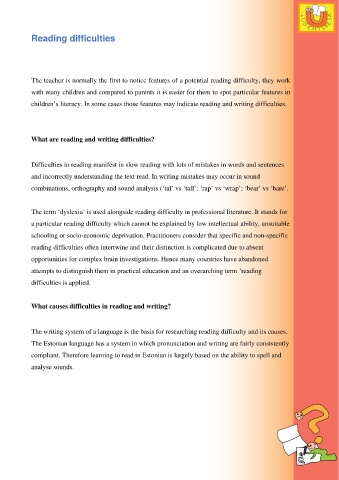Page 139 - Reading Nest - The Supportive Literacy Environment Handbook
P. 139
Reading difficulties
The teacher is normally the first to notice features of a potential reading difficulty, they work
with many children and compared to parents it is easier for them to spot particular features in
children’s literacy. In some cases those features may indicate reading and writing difficulties.
What are reading and writing difficulties?
Difficulties in reading manifest in slow reading with lots of mistakes in words and sentences
and incorrectly understanding the text read. In writing mistakes may occur in sound
combinations, orthography and sound analysis (‘tal’ vs ‘tall’; ‘rap’ vs ‘wrap’; ‘bear’ vs ‘bare’.
The term ‘dyslexia’ is used alongside reading difficulty in professional literature. It stands for
a particular reading difficulty which cannot be explained by low intellectual ability, unsuitable
schooling or socio-economic deprivation. Practitioners consider that specific and non-specific
reading difficulties often intertwine and their distinction is complicated due to absent
opportunities for complex brain investigations. Hence many countries have abandoned
attempts to distinguish them in practical education and an overarching term ‘reading
difficulties is applied.
What causes difficulties in reading and writing?
The writing system of a language is the basis for researching reading difficulty and its causes.
The Estonian language has a system in which pronunciation and writing are fairly consistently
compliant. Therefore learning to read in Estonian is largely based on the ability to spell and
analyse sounds.

